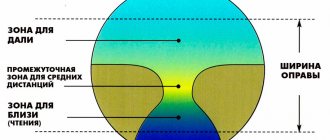The author is a professional tutor, author of textbooks for preparing for the Unified State Exam Igor Vyacheslavovich Yakovlev
Topics of the Unified State Exam codifier: constructing images in lenses, the formula for a thin lens.
The rules for the path of rays in thin lenses, formulated in the previous topic, lead us to the most important statement.
Image theorem. If there is a luminous point in front of the lens, then after refraction in the lens, all rays (or their continuations) intersect at one point.
| Let us recall once again that this does not apply to all rays in general, but only to paraxial ones, that is, those forming small angles with the main optical axis. In the previous topic, we agreed that we consider only paraxial rays. Our rules for the passage of rays through thin lenses work only for them. |
A point is called a point image.
If the refracted rays themselves intersect at a point, then the image is called real. It can be obtained on the screen, since the energy of light rays is concentrated at a point.
If at a point it is not the refracted rays themselves that intersect, but their continuations (this happens when refracted rays diverge after the lens), then the image is called virtual. It cannot be seen on the screen because there is no energy concentrated at the point. A virtual image, let us recall, arises due to the peculiarity of our brain - to complete the diverging rays to their imaginary intersection and to see a luminous point at this intersection. An imaginary image exists only in our consciousness.
The image theorem serves as the basis for constructing images in thin lenses. We will prove this theorem for both a converging and a diverging lens.
Converging lens: real image of a point.
First, let's look at a converging lens.
Let be the distance from the point to the lens and be the focal length of the lens. There are two fundamentally different cases: and (as well as an intermediate case). We will examine these cases one by one; in each of them we will discuss the properties of images of a point source and an extended object. First case: . The point light source is located further from the lens than the left focal plane (Fig. 1).
| Rice. 1. Case a>f: real image of point S |
The beam passing through the optical center is not refracted. We will take an arbitrary ray, construct a point at which the refracted ray intersects the ray, and then show that the position of the point does not depend on the choice of the ray (in other words, the point is the same for all possible rays). Thus, it turns out that all rays emanating from the point, after refraction in the lens, intersect at the point and the image theorem will be proven for the case under consideration.
We will find the point by plotting the further path of the ray. We know how to do this: we draw the secondary optical axis parallel to the beam until it intersects with the focal plane at the secondary focus, after which we draw the refracted ray until it intersects with the ray at point .
Now we will look for the distance from the point to the lens. We will show that this distance is expressed only in terms of and , that is, it is determined only by the position of the source and the properties of the lens, and thus does not depend on the specific ray.
Let us lower the perpendiculars to the main optical axis. Let's also draw it parallel to the main optical axis, i.e. perpendicular to the lens. We get three pairs of similar triangles:
, (1) , (2) . (3)
As a result, we have the following chain of equalities (the formula number above the equal sign indicates from which pair of similar triangles this equality was obtained).
(4)
But, so relation (4) is rewritten as:
. (5)
From here we find the required distance from the point to the lens:
. (6)
As we see, it really does not depend on the choice of beam. Consequently, any ray after refraction in the lens will pass through the point we constructed, and this point will be a real image of the source
The image theorem is proven in this case.
The practical importance of the image theorem is this. Since all the rays of the source intersect after the lens at one point - its image - then to construct the image it is enough to take the two most convenient rays. Which ones exactly?
If the source does not lie on the main optical axis, then the following are suitable as convenient rays:
- a ray passing through the optical center of the lens - it is not refracted; - a ray parallel to the main optical axis - after refraction it goes through the focus.
The construction of an image using these rays is shown in Fig. 2.
| Rice. 2. Constructing an image of a point S that does not lie on the main optical axis |
If the point lies on the main optical axis, then there is only one convenient ray left - running along the main optical axis. We have to take the “inconvenient” one as the second beam (Fig. 3).
| Rice. 3. Constructing an image of a point S lying on the main optical axis |
Let's look again at expression (5). It can be written in a slightly different form, more attractive and memorable. Let's first move the unit to the left:
Now let's divide both sides of this equality by a:
(7)
Relationship (7) is called the thin lens formula (or simply the lens formula). So far, the lens formula has been obtained for the case of a converging lens and for . In the future, we will derive modifications of this formula for other cases.
Now let's return to relation (6). Its importance goes beyond the fact that it proves the image theorem. We also see that it does not depend on the distance (Fig. 1, 2) between the source and the main optical axis!
This means that no matter what point on the segment we take, its image will be at the same distance from the lens. It will lie on a segment - namely, at the intersection of the segment with a ray that will go through the lens without refraction. In particular, the image of a point will be a point.
Thus, we have established an important fact: the image of a segment is a segment. From now on, we call the original segment, the image of which we are interested in, an object and denote it in the drawings with a red arrow. We will need the direction of the arrow in order to monitor whether the image is straight or inverted.
What are lenses in physics?
This concept means absolutely any object that is capable of changing the direction of propagation of electromagnetic radiation. This is a general definition of lenses in physics, which includes optical glasses, magnetic and gravitational lenses.
You may be interested in:Daily planning in the preparatory, junior, middle, senior groups according to the Federal State Educational Standard
In this article, the main attention will be paid to optical glasses, which are objects made of transparent material and limited to two surfaces. One of these surfaces must necessarily have curvature (that is, be part of a sphere of finite radius), otherwise the object will not have the property of changing the direction of propagation of light rays.
Converging lens: the actual image of an object.
Let's move on to looking at images of objects.
Let us remind you that for now we are within the framework of the case. Three typical situations can be distinguished here. 1. . The image of the object is real, inverted, enlarged (Fig. 4; double focus is indicated). From the lens formula it follows what will happen in this case (why?).
| Rice. 4.: real image, inverted, enlarged |
This situation is realized, for example, in slide projectors and movie cameras - these optical devices provide an enlarged image on the screen of what is on the film. If you've ever shown slides, then you know that the slide needs to be inserted into the projector upside down - so that the image on the screen looks correct, and does not end up upside down.
The ratio of the size of the image to the size of the object is called the linear magnification of the lens and is denoted by G - (this is the capital Greek “gamma”):
.
From the similarity of triangles we get:
. (8)
Formula (8) is used in many problems where linear magnification of the lens appears.
2. . In this case, from formula (6) we find that and . The linear magnification of the lens according to (8) is equal to unity, i.e. the size of the image is equal to the size of the object (Fig. 5).
| Rice. 5.a=2f: image size equals object size |
3. . In this case, it follows from the lens formula that (why?). The linear magnification of the lens will be less than one - the image is real, inverted, reduced (Fig. 6).
| Rice. 6.a>2f: real image, inverted, reduced |
This situation is common for many optical instruments: cameras, binoculars, telescopes - in a word, those in which images of distant objects are obtained. As an object moves away from the lens, its image decreases in size and approaches the focal plane.
We have completely completed our consideration of the first case. Let's move on to the second case. It will no longer be so voluminous.
Table
Lens selection table:
| Radius of curvature | Width radius | Lens diameter | Lens thickness | Lens refraction | |
| Myopia | 8.0 8.2 | 9.0 x 0.5 9.2 x 1.0 | 13.5/10.0 | 0.17 | -5.0 -10.0 |
| Afakia | 8.0 8.2 | 9.0 x 0.5 9.2 x 1.0 | 13.5/9.00 | 0.25 | +10.0 +14.0 |
| Keratoconus | 7.2 7.4 | 7.5 x 1.0 7.9 x 1.5 | 15.5/9.5 | 0.35 | -10.0 -10.05 |
Author's rating
Author of the article
Alexandrova O.M.
Articles written
2029
about the author
Was the article helpful?
Rate the material on a five-point scale!
If you have any questions or want to share your opinion or experience, write a comment below.
Converging lens: virtual image of a point.
Second case: . A point light source is located between the lens and the focal plane (Fig. 7).
| Rice. 7. Case a < f: virtual image of a point |
Along with a ray traveling without refraction, we again consider an arbitrary ray. However, now at the exit from the lens two diverging rays are obtained and . Our eye will continue these rays until they intersect at the point.
The image theorem states that a point will be the same for all rays emanating from a point. We will prove this again using three pairs of similar triangles:
Again denoting through the distance from to the lens, we have the corresponding chain of equalities (you can easily figure it out):
. (9)
From here
. (10)
The value does not depend on the ray, which proves the image theorem for our case. So, - an imaginary image of the source. If the point does not lie on the main optical axis, then to construct an image it is most convenient to take a ray passing through the optical center and a ray parallel to the main optical axis (Fig. 8).
| Rice. 8. Constructing an image of a point S that does not lie on the main optical axis |
Well, if the point lies on the main optical axis, then there is nowhere to go - you will have to be content with the beam falling obliquely on the lens (Fig. 9).
| Rice. 9. Constructing an image of a point S lying on the main optical axis |
Relationship (9) leads us to a version of the lens formula for the case under consideration. First we rewrite this relationship as:
,
and then divide both sides of the resulting equality by a:
. (11)
Comparing (7) and (11), we see a slight difference: the term is preceded by a plus sign if the image is real, and a minus sign if the image is imaginary.
The value calculated by formula (10) also does not depend on the distance between the point and the main optical axis. As above (remember the reasoning with the point), this means that the image of the segment in Fig. 9 will be a segment.
Converging lens: virtual image of an object.
Taking this into account, we can easily construct an image of an object located between the lens and the focal plane (Fig. 10). It turns out imaginary, direct and enlarged.
| Rice. 10.: virtual image, direct, enlarged |
This is the image you see when you look at a small object through a magnifying glass - a magnifying glass. The case has been completely resolved. As you can see, it is qualitatively different from our first case. This is not surprising - after all, between them lies an intermediate “catastrophic” case.
Converging lens: object in the focal plane.
Intermediate case:.
The light source is located in the focal plane of the lens (Fig. 11). As we remember from the previous section, the rays of a parallel beam, after refraction in a collecting lens, will intersect in the focal plane - namely, at the main focus if the beam is incident perpendicular to the lens, and at the secondary focus if the beam is obliquely incident. Taking advantage of the reversibility of the path of rays, we conclude that all rays of the source located in the focal plane, after leaving the lens, will go parallel to each other.
| Rice. 11. a=f: no image |
Where is the image of the point? No image available. However, no one forbids us to consider that parallel rays intersect at an infinitely distant point. Then the image theorem remains valid in this case - the image is at infinity.
Accordingly, if an object is entirely located in the focal plane, the image of this object will be at infinity (or, which is the same thing, will be absent).
So, we have fully considered the construction of images in a converging lens.
Diverging lens: virtual image of a point.
Fortunately, there is not such a variety of situations as for a converging lens.
The nature of the image does not depend on the distance at which the object is from the diverging lens, so there will be only one case. Again we take a ray and an arbitrary ray (Fig. 12). At the exit from the lens we have two diverging rays and, which our eye completes until they intersect at the point.
| Rice. 12. Virtual image of point S in a diverging lens |
We again have to prove the image theorem - that the point will be the same for all rays. We act using the same three pairs of similar triangles:
.
We have:
(12)
From here
. (13)
The value b does not depend on the ray span, therefore the continuations of all refracted rays span will intersect at a point - an imaginary image of the point. The image theorem is thus completely proven.
Let us recall that for a collecting lens we obtained similar formulas (6) and (10). In their case, the denominator turned to zero (the image went to infinity), and therefore this case distinguished between fundamentally different situations and .
But in formula (13) the denominator does not vanish for any a. Therefore, for a diverging lens there are no qualitatively different situations for the location of the source - here, as we said above, there is only one case.
If a point does not lie on the main optical axis, then two rays are convenient for constructing its image: one goes through the optical center, the other goes parallel to the main optical axis (Fig. 13).
| Rice. 13. Constructing an image of a point S that does not lie on the main optical axis |
If the point lies on the main optical axis, then the second ray has to be taken arbitrarily (Fig. 14).
| Rice. 14. Constructing an image of a point S lying on the main optical axis |
Relationship (13) gives us another version of the lens formula. First let's rewrite:
,
and then divide both sides of the resulting equality by a:
(14)
This is what the lens formula for a diverging lens looks like.
The three lens formulas (7), (11) and (14) can be written uniformly:
if the following sign convention is observed:
— for a virtual image the value is considered negative; — for a diverging lens, the value is considered negative.
This is very convenient and covers all the cases considered.
Product radius
To ensure that the lenses fit snugly on the cornea, it is important to measure the radius of curvature. In optics, such parameters are abbreviated as BCR or BC. The curvature of the rear may be called the rear center optic. The basis of the curve is the radius, which is described in the recipe. It contains numbers.
If they are low, then this indicates a curved surface. High numbers indicate a flat cornea.
It is important to determine the exact radius value. The tightness of contact of the lens to the surface of the eye depends on these indicators. This affects the process of oxygen exchange and lacrimation.











